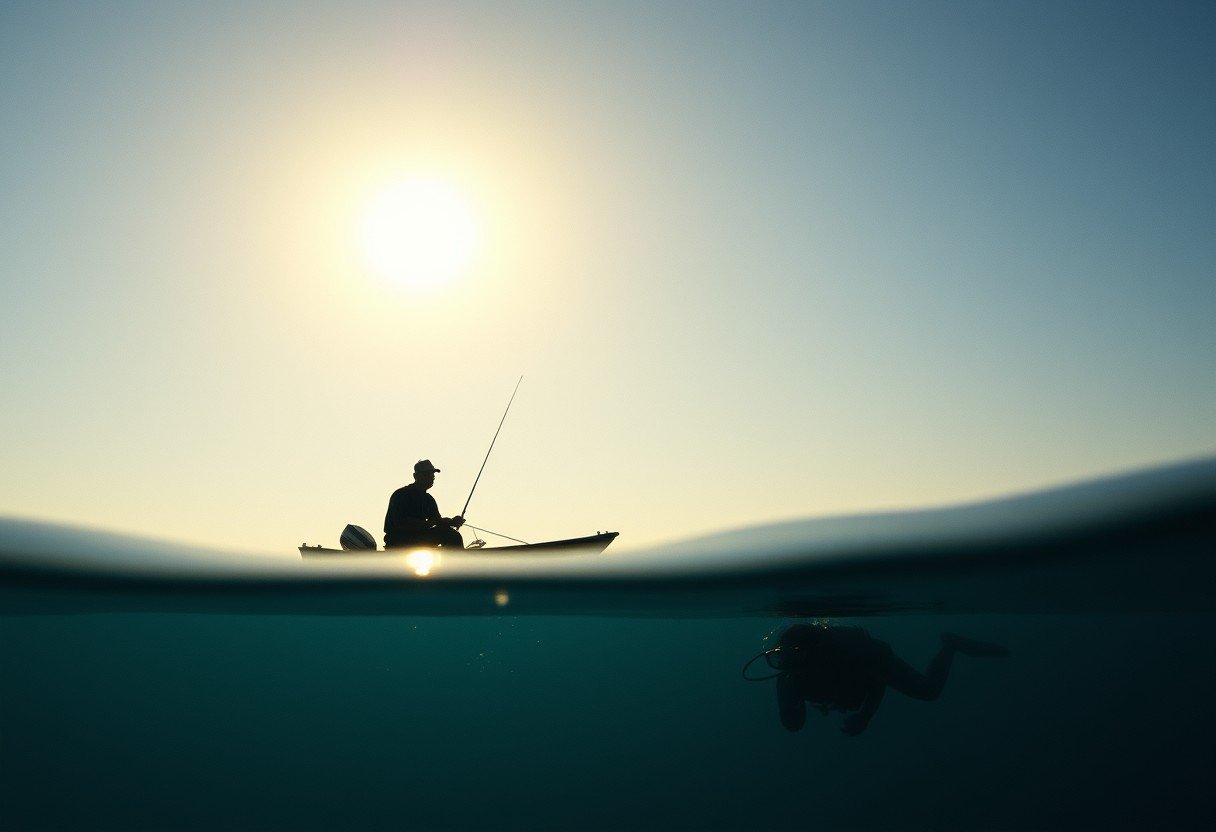Ever wondered why fish bite more at certain times of the day? The answer is often right above you. The height of the sun in the sky directly impacts a fish’s behavior and your visibility on the water. Understanding how to use the sun’s angle can transform your fishing strategy, helping you know when and where to cast your line for a more successful day, whether you’re in a boat or observing from below like a diver.
Why the Sun’s Angle Matters to a Fisherman
As a fisherman, the sun is more than just a source of light; it’s a tool that can guide your strategy. The angle of the sun above the horizon dictates how light penetrates the water, which in turn affects everything from fish activity levels to your ability to see what’s happening beneath the surface.
When the sun is low on the horizon, during early morning or late afternoon, the light enters the water at a softer angle. This creates ideal feeding conditions for many species of fish. Fish tend to be less cautious and more active during these low-light periods, making them more likely to strike your lure.
Conversely, a high sun, especially around noon, can be challenging. The direct overhead light creates intense glare on the water’s surface, making it difficult for you to spot fish or underwater structures. Fish often react to this bright light by moving to deeper water or seeking cover, making them harder to catch.
How Light Changes from the Boat to the Diver
The world looks completely different from a boat on the surface compared to the view of a diver underwater. Light behaves uniquely as it passes through water, creating two distinct environments for the fisherman and the diver.
For the fisherman, the primary concern is surface glare and reflection. The diver, however, experiences a world where light diminishes and colors fade with depth. What appears bright and clear from the boat can be dark and blue from the diver’s perspective just a few feet below.
This difference in perception is crucial. A fisherman might see a shadow and cast towards it, but a diver would see how that shadow provides cover for fish. Understanding both viewpoints can lead to a more complete picture of the underwater habitat.
| Perspective | Fisherman (Above Water) | Diver (Underwater) |
| Sunlight | Experiences direct sunlight and surface glare. | Sees filtered, scattered light that decreases with depth. |
| Visibility | Can see a wide area but is limited by water clarity and reflection. | Has a limited visual range, with colors like red disappearing first. |
| Fish Behavior | Observes surface activity and shadows. | Sees how fish use structure and depth for cover. |
Simple Ways to Measure the Sun’s Height
You don’t need to be an astronomer to gauge the sun’s position. While professional mariners might use a sextant, there are simpler methods and tools available to any fisherman. Knowing the sun’s approximate height helps you predict fish behavior and plan your day on the water.
Modern technology makes this incredibly easy. Many smartphone apps can provide the exact altitude and azimuth of the sun for your specific location and time. This takes the guesswork out of determining the sun’s position.
However, you can also use simple observation. A good rule of thumb is to pay attention to the length of shadows. Long shadows mean a low sun angle (good for fishing), while short or non-existent shadows indicate a high sun (time for fish to seek cover).
Several factors will always influence your measurement and the sun’s actual position:
- Your geographical latitude
- The current time of year or season
- Local weather conditions, such as cloud cover
By keeping these factors in mind, you can make more accurate predictions about the lighting conditions under the water.
How Seasons and Location Change the Sun’s Position
The sun’s path across the sky is not the same every day. It changes dramatically with the seasons and your location on Earth, which has a direct impact on your fishing trips. This is all due to the tilt of the Earth’s axis.
During the summer, the sun is much higher in the sky, leading to longer days and more intense, direct sunlight. In the winter, the sun stays lower on the horizon, resulting in shorter days and softer light. This seasonal shift means your prime fishing times in December will be different from your best times in July.
Your geographic location also plays a significant role. If you are fishing closer to the equator, the sun’s angle will be relatively high and consistent throughout the year. In contrast, locations closer to the poles experience extreme variations, with very high sun in the summer and very low sun in the winter. Understanding this local context is key to adapting your strategy year-round.
Turning Sun Knowledge into More Catches
Applying your understanding of the sun’s height is where theory turns into a tangible advantage. By strategically planning your outings and adapting your techniques based on the sun’s position, you can significantly increase your catch rate.
The most straightforward application is timing your trips. Focus your efforts on the “golden hours” of dawn and dusk when the low sun angle encourages fish to feed actively. This simple adjustment can make a huge difference compared to fishing under the harsh midday sun.
You can also use the sun for navigation and positioning. The shadows cast by the sun on the water can reveal underwater structures like drop-offs, weed beds, or rock piles where fish congregate. By positioning your boat to cast along these shadow lines, you can present your lure to fish hiding in cover.
The Science Behind Sunlight and Water
Understanding a little bit of physics can make you a much better fisherman. When sunlight hits the water, it doesn’t just shine straight through. It bends, scatters, and gets absorbed, which changes how the underwater world is illuminated.
This bending of light is called refraction. It’s why a fish you see from your boat isn’t exactly where it appears to be. The light also scatters as it interacts with particles in the water, which affects visibility. Clear water allows for deep light penetration, while murky water scatters light quickly, creating a darker environment below.
This knowledge helps you choose the right lure. In bright, clear conditions with a high sun, natural and less flashy lures often work best. In low-light or murky conditions, brighter colors and lures that create vibration can be more effective at attracting a fish’s attention.
Frequently Asked Questions about Sun Angle and Fishing
How does the sun’s position affect fish behavior?
The sun’s position influences water temperature and light levels, which are major drivers of fish activity. Fish are often most active in low-light conditions, such as dawn and dusk, because they feel safer from predators and the light is less harsh on their eyes.
What are the best times of day to fish based on the sun?
The best times are typically early morning and late evening when the sun is low on the horizon. This is when predatory fish are most actively hunting. Overcast days can also be excellent, as the clouds diffuse the sunlight, creating low-light conditions throughout the day.
How is a diver’s view of the sun different from a fisherman’s?
A diver sees a much darker, filtered version of sunlight. As light travels through water, it loses intensity and certain colors are absorbed, with red being the first to disappear. This creates a predominantly blue-green environment with limited visibility compared to the fisherman’s view from the surface.
Do I need special tools to measure the sun’s angle for fishing?
No, special tools are not necessary for most fishermen. You can effectively gauge the sun’s angle by observing the time of day and the length of shadows. However, smartphone apps like Sun Surveyor can provide precise data if you want to be more technical.
Why is the sun lower in the sky during winter?
The sun appears lower in the sky during winter because of the tilt of the Earth’s axis. In winter, your hemisphere is tilted away from the sun, causing the sun’s rays to strike at a lower, more indirect angle. This results in shorter days and less intense sunlight.









Leave a Comment